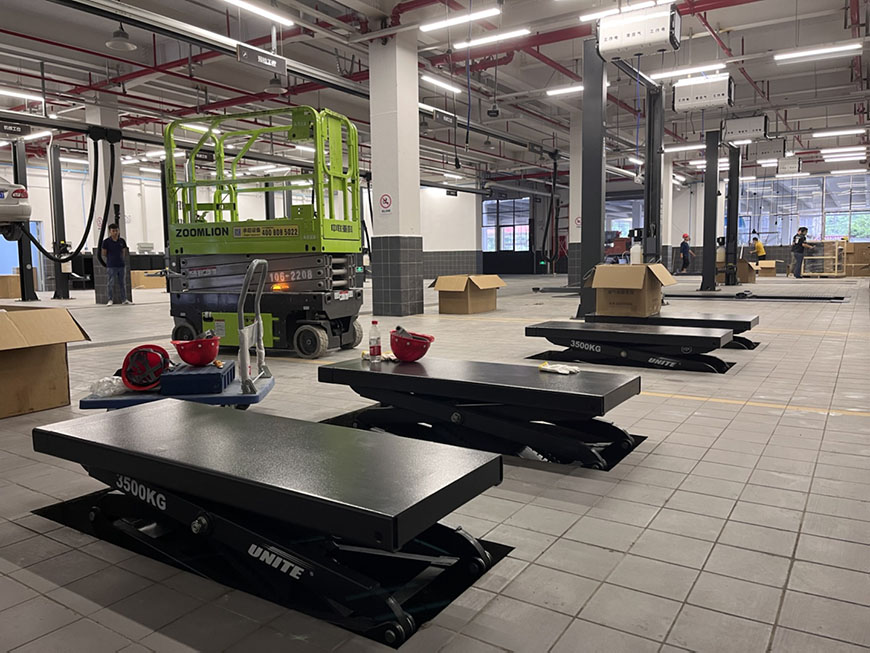In the ever-evolving world of motorcycling, efficiency, convenience, and safety remain paramount for riders and mechanics alike. Whether you’re an enthusiast maintaining your prized two-wheeled companion or a professional in the motorcycle repair industry, investing in a high-quality motorcycle lift can be a game-changer. In this comprehensive guide, we will explore the benefits and functionalities of motorcycle lifts, their various types, safety considerations, and the key factors to consider when choosing the ideal lift for your needs.
I. Understanding Motorcycle Lifts
A motorcycle lift is a specialized piece of equipment designed to elevate motorcycles, providing easy access to critical components and enhancing maneuverability during maintenance and repair tasks. These lifts typically feature hydraulic, pneumatic, or mechanical systems, enabling users to raise and lower motorcycles with minimal effort.
II. Types of Motorcycle Lifts
- Hydraulic Motorcycle Lifts: Hydraulic motorcycle lifts are the most popular choice due to their ease of use and robust lifting capacity. A hydraulic system utilizes fluid pressure to raise and lower the lift platform, allowing for smooth and controlled movements. These lifts are suitable for a wide range of motorcycles, from lightweight cruisers to heavy touring bikes.
- Pneumatic Motorcycle Lifts: Pneumatic lifts rely on compressed air to lift the motorcycle. They are suitable for smaller bikes and provide an affordable option for hobbyists or motorcycle owners with limited space. However, they may not have the same lifting capacity as hydraulic lifts.
- Scissor Motorcycle Lifts: Scissor lifts use a mechanical mechanism resembling scissors to raise the platform. These lifts are ideal for small workshops or home garages due to their compact design. While they offer sufficient lifting power, they might require more effort to operate compared to hydraulic or pneumatic lifts.
III. Advantages of Motorcycle Lifts
- Increased Accessibility: By elevating the motorcycle to a comfortable working height, motorcycle lifts allow easy access to the engine, wheels, brakes, and other components. This enhances the efficiency and speed of maintenance and repair tasks, reducing the time spent on labor-intensive jobs.
- Enhanced Safety: Working on motorcycles while they are on the ground can be hazardous, with the potential for back strain, accidental tipping, or parts rolling away. Motorcycle lifts provide a stable and secure platform, significantly reducing the risk of accidents and injuries during maintenance.
- Time-Saving: Motorcycle lifts streamline the repair and maintenance process by reducing the need for bending or crouching, which can be time-consuming and uncomfortable. Mechanics can work more efficiently, ensuring faster turnaround times for clients.
- Improved Precision: The ability to adjust the lift height precisely allows for precise positioning, especially when aligning wheels, adjusting suspension components, or performing intricate tasks like carburetor tuning.
- Versatility: Many motorcycle lifts come with additional features, such as removable panels, wheel chocks, and extensions, making them suitable for various motorcycle types and customization projects.
IV. Safety Considerations
- Weight Capacity: Always ensure that the motorcycle lift you choose can support the weight of your heaviest motorcycle. Exceeding the lift’s weight capacity can lead to dangerous accidents.
- Stability and Construction: Opt for lifts made from high-quality materials, featuring stable construction and a secure locking mechanism. Stability is essential to prevent the lift from wobbling or tipping over during use.
- Safety Features: Look for lifts equipped with safety features like safety locks and non-slip surfaces to provide an added layer of protection while working on your motorcycle.
- Proper Positioning: Position the motorcycle correctly on the lift, ensuring the weight is distributed evenly to prevent any imbalances or instability.
V. Choosing the Right Motorcycle Lift
- Identify Your Needs: Consider the types of motorcycles you’ll be working on, your available workspace, and your budget to determine which type of motorcycle lift suits your requirements best.
- Quality and Durability: Invest in a reputable brand known for manufacturing high-quality and durable motorcycle lifts. Look for customer reviews and testimonials to gauge the product’s performance and longevity.
- Weight Capacity and Dimensions: Check the lift’s weight capacity and dimensions to ensure it can accommodate the motorcycles you plan to work on comfortably.
- Additional Features: Evaluate additional features like built-in wheel chocks, drop panels, or extension options that can enhance the lift’s versatility and convenience.
Introducing the U-M02 Motorcycle Lift Table Equipped with a state-of-the-art safety valve, this hydraulic system boasts an anti-explosion feature, ensuring your peace of mind during every lift. Additionally, the U-M02 comes equipped with a height limit switch, providing precise control over the lift’s elevation, guaranteeing a safe and secure working environment.

VI. Conclusion
Motorcycle lifts are indispensable tools for both motorcycle enthusiasts and professionals in the repair and maintenance industry. Their ability to enhance efficiency, accessibility, and safety while working on motorcycles sets them apart as essential investments. By understanding the different types of motorcycle lifts, considering safety factors, and choosing the right one to suit your needs, you can elevate your motorcycle maintenance experience to new heights. Always remember to prioritize quality, stability, and safety, and you’ll undoubtedly reap the rewards of a reliable and efficient motorcycle lift for years to come.

